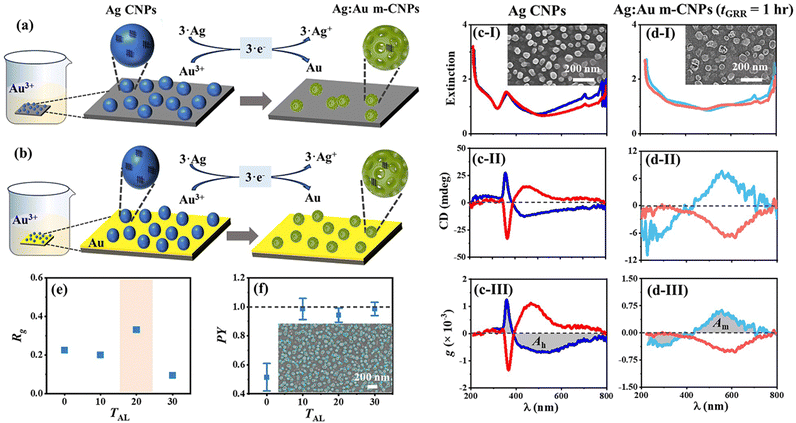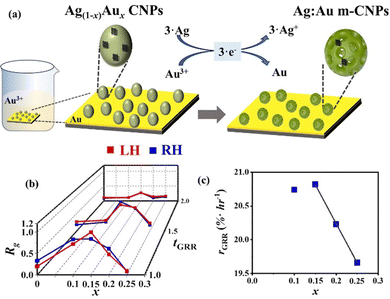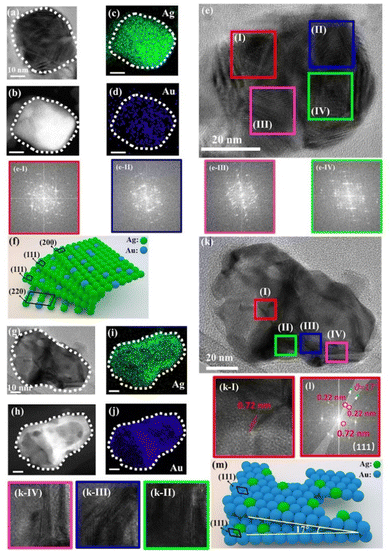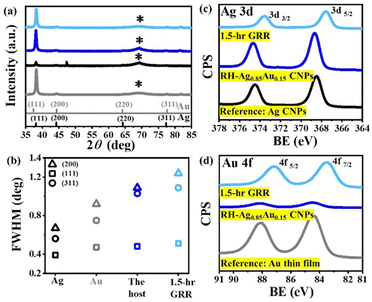Mesoporous alloy chiral nanoparticles with high production yield and strong optical activities†
Yicong
Ma
a,
Lin
Yang
b,
Yu
Chen
c,
Xiaopeng
Bai
d,
Geping
Qu
e,
Tao
Yao
f,
Xiangchen
Hu
c,
Jianfang
Wang
 d,
Zongxiang
Xu
e,
Yi
Yu
d,
Zongxiang
Xu
e,
Yi
Yu
 c and
Zhifeng
Huang
c and
Zhifeng
Huang
 *f
*f
aDepartment of Physics, Hong Kong Baptist University, Kowloon Tong, Hong Kong SAR, China
bHKBU Institute for Research and Continuing Education Shenzhen, Guangdong 518057, China
cSchool of Physical Science and Technology, ShanghaiTech University, Shanghai, 201210, China
dDepartment of Physics, The Chinese University of Hong Kong, Shatin, NT, Hong Kong SAR, China
eDepartment of Chemistry, Southern University of Science and Technology, Shenzhen, Guangdong, 518055, China
fDepartment of Chemistry, The Chinese University of Hong Kong, Shatin, NT, Hong Kong SAR, China. E-mail: zfhuang@cuhk.edu.hk
First published on 10th November 2023
Abstract
Applying galvanic replacement reactions (GRRs) to the host chiral nanoparticles (CNPs) is an exclusive method to generate alloy CNPs with mesoporous structures through chirality transfer. However, the GRR-mediated chirality transfer is too inefficient to impose strong optical activities on the alloy mesoporous CNPs (or m-CNPs). Here we dope the host with gold (Au) to significantly enhance the chirality transfer, and additionally employ the Au adhesion layer to increase the production yield (PY) of binary m-CNPs.
Chirality refers to an asymmetric configurational property in which an object cannot be superimposed on its mirror image. Chirality naturally occurs in biological systems that overwhelmingly exhibit homochirality, a unique property in which biological building blocks, such as amino acids and sugars, predominantly consist of one of two chiral configurations. Homochirality essentially results in a wide range of asymmetric biochemical processes and functions, and various physiological effects within biosystems are essentially associated with the stereochemical configuration and conformation of biomolecules. As a result, an enantioselective synthesis of molecules with controllable chirality, functioning as e.g. pharmaceutics and pesticides, has become one of the most important topics in modern chemistry.1 Heterogeneous asymmetric catalysis, occurring at a liquid-chiral catalyst interface, has been developed for mass production of single-enantiomer molecules.2 Currently, a new type of chiral catalyst, inorganic CNPs composed of structural chirality at the atomic/molecular scale,3 has been introduced to control enantiopreference4–7via an enantiospecific interaction with molecular substrates.8,9 Inorganic CNPs, fabricated via chirality transfer from either chiral ligands10 or macroscopic rotation in the clockwise/counterclockwise direction,11 generally have non-porous nanostructures.12 Large surface-to-volume ratio of catalysts, resulting from e.g. structural porosification, is favoured for obtaining high PY. Therefore, generating inorganic m-CNPs is crucial for the asymmetric catalysis. GRR of silver (Ag) CNPs, serving as the host, was conducted in an aqueous electrolyte containing HAuCl4, H2PtCl4 or H2PdCl4 to generate binary (Ag:Au, Ag:Pt and Ag:Pd, respectively) m-CNPs,13 which is an exclusive approach to fabricate alloy m-CNPs, to the best of our knowledge. However, the m-CNPs generally have weak optical activity, which is generally characterized with circular dichroism (CD) referred to as the differential absorption (or extinction) of left-handed and right-handed circularly polarized light by a chiral object. Such low optical activity illustrates that the GRR-mediated chirality transmission is too insufficient13,14 to provide high enantioselectivity in asymmetric syntheses.
Herein, we employ an Au adhesion layer on which the host Ag CNPs are deposited to significantly increase the PY of m-CNPs, and dope the host with Au to enhance the GRR-mediated chirality transfer and thus impose strong optical activities onto the binary m-CNPs.
Binary Ag:Au m-CNPs were fabricated through the GRR of the host Ag CNPs in an aqueous HAuCl4 solution (Fig. 1a), according to13
| 3Ag(s,CNPs) − 3e− → 3Ag+(aq) | (1) |
| AuCl4− + 3e− → Au(s) + 4Cl−(aq) | (2) |
 | ||
| Fig. 1 A gold (Au) adhesion layer (with a thickness (TAL) of 20 nm) facilitates the formation of Ag:Au m-CNPs via GRR of the host Ag CNPs (with a nominal P of 8 nm and height (H) of 80 nm). Schematics: GRR (in a HAuCl4 solution) of the Ag CNPs on a sapphire (a) without and (b) with the deposition of the Au adhesion layer, to form the binary Ag:Au m-CNPs. The host and m-CNPs have atomic-scale chirality composed of the chiral twisting of multiple achiral facets, represented with the “#”-like symbols. (c) The close-packed arrays of Ag CNPs, deposited on the Au adhesion layer, are (d) applied to the GRR for a duration (tGRR) of 1 h, characterized with ultraviolet (UV)-visible-NIR spectroscopies of (I) extinction, (II) CD, and (III) anisotropic g-factor (c) and (d) LH: red and pink lines; RH: blue and cyan lines. Plots of (e) efficiency of chirality transfer Rg (eqn (4)) and (f) production yield (PY) of the binary m-CNPs (eqn (5)) versus TAL, resulting from the 1 h GRR of the host. Insets: Scanning electron microscopy (SEM) top-down images of (c-I) the host and (d-I) Ag:Au m-CNPs; the grey regions in (c-III) and (d-III) represent Ah and Am (eqn (4)), respectively; (f) SEM top-down image of the m-CNPs used to calculate Nm (eqn (5)). | ||
A close-packed array of Ag CNPs, functioning as the host in the GRR, was deposited by glancing angle deposition (GLAD) on a supporting substrate of sapphire or silicon wafer (Fig. S1a-I and a-II, ESI†). The Ag CNPs, without a porous structure (inset in Fig. 1c-I), were sculpted in left-handedness (LH) and right-handedness (RH) via substrata rotation in the counterclockwise and clockwise direction, respectively.15 The host, composed of a nominal helical pitch (P) of sub-10 nm owing to fast substrate rotation during GLAD (eqn (S1), ESI†), exhibits an extinction (resulting from localized surface plasmon resonance or LSPR) of the transverse and longitudinal mode at ≈370 nm and the visible-near infrared (NIR) region, respectively (Fig. 1c-I).16 On resonance with the LSPR, the host exhibits bisignated CD peaks. Switching the helicity from LH to RH barely affected the LSPR but caused the CD spectrum to flip around the zero-CD axis (Fig. 1c-II), illustrating that the host has optical activity intrinsically ascribed to their helicity. The anisotropic g-factor, denoting a mean optical activity of individual CNPs in the array, is calculated by17
g = CD/16![[thin space (1/6-em)]](https://www.rsc.org/images/entities/char_2009.gif) 500Ext 500Ext | (3) |
The 1 h GRR of the host Ag CNPs caused the transverse LSPR and CD modes of the host to be significantly suppressed, accompanied by the detection of the LSPR and CD signals at a wavelength of ≈580 nm assigned to the precipitated Au (Fig. 1d-I and d-II). Switching the helicity of the host from LH to RH also induced the CD spectrum of the GRR products to flip around the zero-CD axis. Furthermore, the GRR-treated CNPs appeared to have mesoporous structures (inset in Fig. 1d-I). These experimental results illustrate the formation of binary Ag:Au m-CNPs via the GRR-mediated chirality transfer from the host, with an efficiency evaluated by
| Rg = Am/Ah | (4) |
| PY = Nm/Nh | (5) |
However, Rg = 0.334 illustrates that 66.6% of optical activity is sacrificed in the GRR-mediated chirality transfer, mainly owing to the structural porosification. We found that doping the host copper (Cu) CNPs with Au could facilitate the chirality transmission, because of the dopant Au functioning as a structural scaffold.14 In this work, the doping was adopted to produce the Ag:Au m-CNPs with strong optical activities (Fig. 2a). Layer-by-layer GLAD was conducted to dope the host Ag CNPs with Au, leading to the formation of non-porous host Ag(1−x)Aux CNPs where the atomic percentage x of the dopant Au was adjusted in a range of 0–0.25. Then, the 2 h GRR was applied to the binary host, which was attached to the 20 nm-thick Au adhesion layer (Fig. S3 and S4, ESI†). Monitoring the LSPR and optical activities of the host binary CNPs as a function of x and the GRR duration tGRR (Fig. S5 and S6, ESI†) revealed that the GRR-mediated chirality transfer occurs the most efficiently at x = 0.15 for a given tGRR (Fig. 2b). Without the doping of Au (i.e., x = 0), Rg is 0.334 (for the RH-host) and 0.201 (LH) for tGRR = 1.0 h, 0.183 (RH) and 0.273 (LH) for tGRR = 1.5 h, and 0.090 (RH) and 0.113 (LH) for tGRR = 2.0 h. For comparison, doping the host of Au with x = 0.15 significantly amplifies the Rg values: 0.844 (RH) and 0.997 (LH) for tGRR = 1.0 h; 0.839 (RH) and 0.753 (LH) for tGRR = 1.5 h; 0.277 (RH) and 0.271 (LH) for tGRR = 2.0 h. Elongating the GRR generally tends to deteriorate the chirality transfer (Fig. 2b) and PY (Fig. S7, ESI†), because the GRR-induced structural porosification inevitably destroys the chiral structures. Furthermore, the rate of the GRR (rGRR) was evaluated by characterizing the atomic percentage (at%) of Ag in the binary Ag:Au m-CNPs as a function of tGRR (Fig. S8, ESI†). As shown with the evaluation (Fig. 2c), rGRR slightly increases from 20.7 to 20.8% h−1 with an increase of x from 0.1 to 0.15, and then quickly decreases with an increase of x from 0.15 to 0.25 (having a decreasing slope of −11.6% h−1). This illuminates that the 15% dopants Au serve as the structural scaffold to not only support the galvanic replacement but accelerate the structural porosification, which is advantageous for efficient chirality transfer to generate the binary m-CNPs with strong optical activities.
The 20 nm-thick Au adhesion layer and 15% dopants Au allow for optimizing the GRR-mediated chirality transmission and PY of the binary m-CNPs. To further understand the GRR-controlled chirality transfer, the host and the m-CNPs were comprehensively characterized. The host Ag0.85Au0.15 CNPs are composed of the solid-state solution without a mesoporous structure (Fig. 3a–e), and they are polycrystalline mainly consisting of the (111) facet (Fig. 4a). Many Moiré patterns were observed in the binary host (Fig. 3e), owing to chiral twisting of multiple achiral facets of (111), (200), and (220) (Fig. 3f). Such chiral twisting essentially imposes the chiroptical activity on the binary host.18 More than two facets were involved in the chiral twisting, making the quantitative evaluation of the twisting angle difficult. The 1.5 h GRR porosifies the binary host (Fig. 3g), and the product Ag:Au m-CNPs are also made of the solid-state solution (Fig. 3h–j). Analogous to the binary host, the binary m-CNPs show many Moiré patterns (Fig. 3k). The GRR-induced porosification tends to preferentially destroy the minor (200) and (220) facets, resulting in the formation of the chiral twisting of two (111) facets in 17° (Fig. 3l and m). This characterization illuminates that the galvanic replacement of Ag with Au atoms in the chiral twisting lattices, particularly in the (111) facets, accounts for the GRR-mediated chirality transmission. The deterioration of optical activity with the elongation of GRR can be ascribed to the fact that the number of achiral facets involved in the chiral twisting reduces with the GRR-induced porosification. The galvanic replacement of Ag with Au can be verified by the suppression of the Ag 3d peaks (Fig. 4c) and amplification of the Au 4f peaks (Fig. 4d). The GRR-mediated alloying caused a downshift of the X-ray photoelectron spectroscopy (XPS) peaks compared to the binary host. The GRR also broadened the peaks of the (111), (200) and (311) facets (Fig. 4b), ascribed to the porosification-induced decrease of the grain sizes.
In summary, GRR of the host Ag CNPs in HAuCl4 enables the fabrication of binary Ag:Au m-CNPs. Doping the host with 15% Au atoms, which function as the structural scaffold to support the porosification and accelerate the galvanic replacement of Ag with Au, facilitates the chirality transfer from the host to the m-CNPs through replacing Ag with Au atoms in the chiral twisting (111) facets. The 20 nm-thick Au adhesion layer enhances the host-substrate adhesion, leading to a significant increase in the PY of the binary m-CNPs. This work devises an effective method to generate alloy m-CNPs with high production yield and strong optical activities. It provides an insight into understanding the GRR-mediated chirality transmission at the atomic scale, and paves the way to employing alloy m-CNPs for enantioselective synthesis of single-enantiomer pharmaceutics through heterogeneous asymmetric catalysis.
Z. F. H. acknowledges financial support from NSFC/22075239, GRF/12302320 and 12301321, Shenzhen Science and Technology Plan Project (Shenzhen, Hong Kong and Macau Category C)/SGDX20210823104205034, CUHK/4053558 and 3134308. L. Y. acknowledges the Natural Science Foundation of Guangdong Province of China/2021A1515010045.
Conflicts of interest
There are no conflicts to declare.References
- A. Baiker, Chem. Soc. Rev., 2015, 44, 7449–7464 RSC.
- I. Schrader, S. Neumann, A. Sulce, F. Schmidt, V. Azov and S. Kunz, ACS Catal., 2017, 7, 3979–3987 CrossRef CAS.
- L. Yang, J. J. Liu, P. Sun, Z. Y. Ni, Y. C. Ma and Z. F. Huang, Small, 2020, 16, 2001473 CrossRef CAS PubMed.
- S. Li, J. Liu, N. S. Ramesar, H. Heinz, L. G. Xu, C. L. Xu and N. A. Kotov, Nat. Commun., 2019, 10, 4826 CrossRef PubMed.
- X. Q. Wei, J. J. Liu, G. J. Xia, J. H. Deng, P. Sun, J. J. Chruma, W. H. Wu, C. Yang, Y. G. Wang and Z. F. Huang, Nat. Chem., 2020, 12, 551–559 CrossRef CAS PubMed.
- S. Butcha, S. Assavapanumat, S. Ittisanronnachai, V. Lapeyre, C. Wattanakit and A. Kuhn, Nat. Commun., 2021, 12, 1314 CrossRef CAS PubMed.
- Y. X. Fang, X. Liu, Z. P. Liu, L. Han, J. Ai, G. Zhao, O. Terasaki, C. H. Cui, J. Z. Yang, C. Y. Liu, Z. Y. Zhou, L. W. Chen and S. A. Che, Chem, 2023, 9, 460–471 CAS.
- P. Sun, J. J. Liu, M. Yan and Z. F. Huang, Chem. Commun., 2018, 54, 4270–4273 RSC.
- L. Yang, J. J. Liu, J. H. Deng and Z. F. Huang, InfoMat, 2020, 2, 1216–1224 CrossRef CAS.
- P. Kumar, T. Vo, M. J. Cha, A. Visheratina, J. Y. Kim, W. Q. Xu, J. Schwartz, A. Simon, D. Katz, V. P. Nicu, E. Marino, W. J. Choi, M. Veksler, S. Chen, C. Murray, R. Hovden, S. Glotzer and N. A. Kotov, Nature, 2023, 615, 418–424 CrossRef CAS PubMed.
- W. F. Lau, L. Yang, F. Bai and Z. F. Huang, Small, 2016, 12, 6698–6702 CrossRef CAS PubMed.
- L. Yang, P. Nandi, Y. C. Ma, J. J. Liu, U. Mirsaidov and Z. F. Huang, Small, 2020, 16, 1906048 CrossRef CAS PubMed.
- J. J. Liu, Z. Y. Ni, P. Nandi, U. Mirsaidov and Z. F. Huang, Nano Lett., 2019, 19, 7427–7433 CrossRef CAS PubMed.
- Z. Y. Ni, Y. M. Zhu, J. J. Liu, L. Yang, P. Sun, M. Gu and Z. F. Huang, Adv. Sci., 2020, 7, 2001321 CrossRef CAS PubMed.
- Y. C. Ma, C. Lin, L. F. Cai, G. P. Qu, X. P. Bai, L. Yang and Z. F. Huang, Small, 2022, 18, 2107657 CrossRef CAS PubMed.
- J. J. Liu, L. Yang and Z. F. Huang, Small, 2016, 12, 5902–5909 CrossRef CAS PubMed.
- L. Yang, Y. Ma, C. Lin, G. Qu, X. Bai and Z. Huang, Small, 2022, 18, 2200620 CrossRef CAS PubMed.
- Y. Ma, L. Yang, X. C. Hu, M. Zhang, G. P. Qu, X. P. Bai, H. F. Sun, F. Zhu, X. Y. Zhong, X. Chen, Z. X. Xu, Y. Yu and Z. F. Huang, Adv. Opt. Mater., 2023, 2300696 CrossRef CAS.
Footnote |
| † Electronic supplementary information (ESI) available: Experimental methods, and structural, optical, and reaction rate characterizations. See DOI: https://doi.org/10.1039/d3cc04354a |
| This journal is © The Royal Society of Chemistry 2023 |



